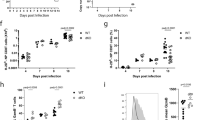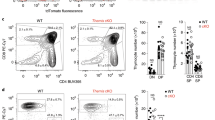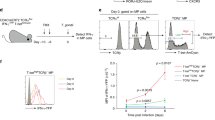Abstract
Activation of the naive T-helper lymphocyte (Thp) directs it down one of two major developmental pathways called Th1 and Th2. Signals transmitted by T cell, co-stimulatory and cytokine receptors control Thp lineage commitment but the mechanism by which these signals are integrated remains a mystery. The interferon-γ (IFNGR) and interleukin 4 (IL-4R) cytokine receptors, in particular, direct the earliest stages of T-helper commitment. Here we report that on engagement of the T-cell receptor (TCR) on Thp cells, rapid co-polarization of IFNGR with the TCR occurs within the developing immunological synapse. Thp cells from the intrinsically Th1-like C57BL/6 mouse strain have significantly more receptor co-polarization than Th2-prone BALB/c Thp cells. Remarkably, in the presence of IL-4, a cytokine required for Th2 differentiation, IFNGR co-polarization with TCR is prevented. This inhibition depends on Stat6, the transcription factor downstream of IL-4R that is required for Th2 differentiation. This cytokine receptor crossregulation provides an explanation for the effect of IL-4 in inhibiting Th1 differentiation. These observations suggest a scenario in which physical co-polarization of critical receptors directs the fate of the naive Thp, and offer a novel function for the immunological synapse in directing cell differentiation. They further suggest a new mechanism of membrane-bound signalling control by the physical disruption of large receptor-rich domains on signalling through a functionally antagonistic receptor.
This is a preview of subscription content, access via your institution
Access options
Subscribe to this journal
Receive 51 print issues and online access
$199.00 per year
only $3.90 per issue
Buy this article
- Purchase on Springer Link
- Instant access to full article PDF
Prices may be subject to local taxes which are calculated during checkout




Similar content being viewed by others
References
Huppa, J. B. & Davis, M. M. T-cell-antigen recognition and the immunological synapse. Nature Rev. Immunol. 3, 973–983 (2003)
Grakoui, A. et al. The immunological synapse: a molecular machine controlling T cell activation. Science 285, 221–227 (1999)
Bromley, S. K. et al. The immunological synapse. Annu. Rev. Immunol. 19, 375–396 (2001)
Viola, A., Schroeder, S., Sakakibara, Y. & Lanzavecchia, A. T lymphocyte costimulation mediated by reorganization of membrane microdomains. Science 283, 680–682 (1999)
Balamuth, F., Leitenberg, D., Unternaehrer, J., Mellman, I. & Bottomly, K. Distinct patterns of membrane microdomain partitioning in Th1 and Th2 cells. Immunity 15, 729–738 (2001)
Madrenas, J. A SLAT in the Th2 signalosome. Immunity 18, 459–461 (2003)
Szabo, S. J., Sullivan, B. M., Peng, S. L. & Glimcher, L. H. Molecular mechanisms regulating Th1 immune responses. Annu. Rev. Immunol. 21, 713–758 (2003)
O'Garra, A. Cytokines induce the development of functionally heterogeneous T helper cell subsets. Immunity 8, 275–283 (1998)
Murphy, K. M. & Reiner, S. L. The lineage decisions of helper T cells. Nature Rev. Immunol. 2, 933–944 (2002)
Miller, M. J., Wei, S. H., Parker, I. & Cahalan, M. D. Two-photon imaging of lymphocyte motility and antigen response in intact lymph node. Science 296, 1869–1873 (2002)
Vereb, G. et al. Cholesterol-dependent clustering of IL-2Ralpha and its colocalization with HLA and CD48 on T lymphoma cells suggest their functional association with lipid rafts. Proc. Natl Acad. Sci. USA 97, 6013–6018 (2000)
Zhu, J., Cote-Sierra, J., Guo, L. & Paul, W. E. Stat5 activation plays a critical role in Th2 differentiation. Immunity 19, 739–748 (2003)
Takaoka, A. et al. Cross talk between interferon-gamma and -alpha/beta signaling components in caveolar membrane domains. Science 288, 2357–2360 (2000)
Fowell, D. J. & Locksley, R. M. Leishmania major infection of inbred mice: unmasking genetic determinants of infectious diseases. Bioessays 21, 510–518 (1999)
Watzl, C. & Long, E. O. Natural killer cell inhibitory receptors block actin cytoskeleton-dependent recruitment of 2B4 (CD244) to lipid rafts. J. Exp. Med. 197, 77–85 (2003)
Chen, C. H. et al. Transforming growth factor beta blocks Tec kinase phosphorylation, Ca2+ influx, and NFATc translocation causing inhibition of T cell differentiation. J. Exp. Med. 197, 1689–1699 (2003)
Lee, K. H. et al. T cell receptor signaling precedes immunological synapse formation. Science 295, 1539–1542 (2002)
Huppa, J. B., Gleimer, M., Sumen, C. & Davis, M. M. Continuous T cell receptor signaling required for synapse maintenance and full effector potential. Nature Immunol. 4, 749–755 (2003)
Lee, K. H. et al. The immunological synapse balances T cell receptor signaling and degradation. Science 302, 1218–1222 (2003)
Poo, W. J., Conrad, L. & Janeway, C. A. Receptor-directed focusing of lymphokine release by helper T cells. Nature 332, 378–380 (1988)
Trambas, C. M. & Griffiths, G. M. Delivering the kiss of death. Nature Immunol. 4, 399–403 (2003)
Reichert, P., Reinhardt, R. L., Ingulli, E. & Jenkins, M. K. Cutting edge: in vivo identification of TCR redistribution and polarized IL-2 production by naive CD4 T cells. J. Immunol. 166, 4278–4281 (2001)
Granucci, F. et al. Inducible IL-2 production by dendritic cells revealed by global gene expression analysis. Nature Immunol. 2, 882–888 (2001)
Welte, T. et al. STAT5 interaction with the T cell receptor complex and stimulation of T cell proliferation. Science 283, 222–225 (1999)
Gamero, A. M. & Larner, A. C. Signaling via the T cell antigen receptor induces phosphorylation of Stat1 on serine 727. J. Biol. Chem. 275, 16574–16578 (2000)
Zhu, J. et al. Transient inhibition of interleukin 4 signaling by T cell receptor ligation. J. Exp. Med. 192, 1125–1134 (2000)
Zhang, Y. et al. Interferon gamma stabilizes the T helper cell type 1 phenotype. J. Exp. Med. 194, 165–172 (2001)
Launois, P. et al. IL-4 rapidly produced by Vβ4 Vα8 CD4+ T cells instructs Th2 development and susceptibility to Leishmania major in BALB/c mice. Immunity 6, 541–549 (1997)
Manes, S. et al. Membrane raft microdomains in chemokine receptor function. Semin. Immunol. 13, 147–157 (2001)
Tsui-Pierchala, B. A., Encinas, M., Milbrandt, J. & Johnson, E. M. Jr Lipid rafts in neuronal signaling and function. Trends Neurosci. 25, 412–417 (2002)
Acknowledgements
We thank A. Shaw, G. Petsko, M. Grusby and G. Lord for thoughtful review of the manuscript, and G. Petsko for advice on the statistical analysis. This work was supported by National Institutes of Health grants. R.M. is a recipient of the Kelli and Gerald Ford Irvington Institute Postdoctoral Fellowship.
Author information
Authors and Affiliations
Corresponding author
Ethics declarations
Competing interests
The authors declare that they have no competing financial interests.
Supplementary information
Supplementary Figure 1
TCRß and IFNGR colocalize at the IS. (PDF 359 kb)
Supplementary Figure 2
Neither IFNγ or Stat1 are required for IFNGR/TCR copolarization. (PDF 1103 kb)
Supplementary Figure 3
Neither the presence of IL-4 nor absence of IFNγ induce IL-4R and TCR copolarization after Thp activation. (PDF 859 kb)
Supplementary Figure 4
The polarization of IFNGR and TCR is not increased in IL-4-deficient BALB/c Thp. (PDF 471 kb)
Supplementary Movie 1
Dynamics of Thp and DC coculture. (MP4 790 kb)
Supplementary Movie 2
4D observation of the dynamics of Thp activation and receptor motility in the presence of OVA protein/peptide-loaded DC. (MOV 2296 kb)
Rights and permissions
About this article
Cite this article
Maldonado, R., Irvine, D., Schreiber, R. et al. A role for the immunological synapse in lineage commitment of CD4 lymphocytes. Nature 431, 527–532 (2004). https://doi.org/10.1038/nature02916
Received:
Accepted:
Published:
Issue Date:
DOI: https://doi.org/10.1038/nature02916
This article is cited by
-
MiR-125a-5p Regulates Vitamin D Receptor Expression in a Mouse Model of Experimental Autoimmune Encephalomyelitis
Neuroscience Bulletin (2020)
-
Stimulus-Dependent Inhibitor of Apoptosis Protein Expression Prolongs the Duration of B Cell Signalling
Scientific Reports (2016)
-
T follicular helper cells in space-time
Nature Reviews Immunology (2016)
-
MiR-125a targets effector programs to stabilize Treg-mediated immune homeostasis
Nature Communications (2015)
-
IL-12 family cytokines: immunological playmakers
Nature Immunology (2012)
Comments
By submitting a comment you agree to abide by our Terms and Community Guidelines. If you find something abusive or that does not comply with our terms or guidelines please flag it as inappropriate.



